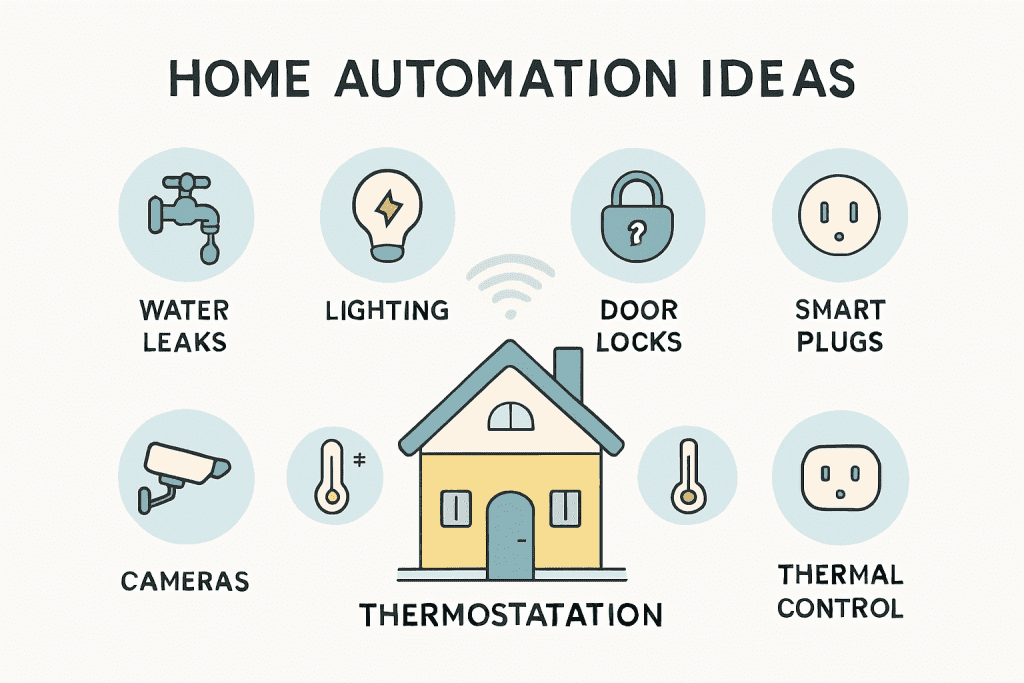Are you tired of juggling multiple remotes, setting alarms manually, or constantly adjusting your thermostat? Imagine if your home could handle all these tasks by itself. Home automation makes that possible, bringing convenience, security, and energy savings right into your daily life.
In this post, I will share the best home automation ideas you can implement today. From simple lighting controls to complete entertainment setups, these tips will help you create a smart home tailored to your needs.
What Is Home Automation and Why Should You Care?
Home automation means using smart technology to control household systems automatically. These can include lighting, heating, security, entertainment devices, and more.
When I first explored automation, I quickly realized how much easier it made managing my home. Tasks that took minutes every day suddenly happened with a tap or on a schedule.
- Convenience: Automate repetitive tasks so you can focus on what matters.
- Security: Keep your home safe with smart cameras, alarms, and locks.
- Energy Efficiency: Use smart thermostats and plugs to reduce utility bills.
- Comfort and Lifestyle: Enjoy personalized lighting and entertainment control.
How Does Home Automation Work?
Most smart homes connect devices to a central hub or a smartphone app. This setup allows different gadgets to communicate and operate together based on your preferences or triggers like time of day.
The popular hubs include Samsung SmartThings, Control4, and Amazon Echo. They support various protocols such as Zigbee, Z-Wave, and Wi-Fi to make integrations seamless.
Top Home Automation Ideas for Every Room
Let’s explore practical ideas you can apply room by room. I found that starting small keeps you motivated before adding complexity.
1. Smart Lighting Automation
Lighting offers an easy, affordable way to begin automating your home. Install smart bulbs or switches to adjust brightness and colors automatically.
- Set schedules to turn lights off and on depending on the time of day.
- Use motion sensors in hallways and bathrooms to reduce wasted power.
- Adjust colors for ambiance—warm lights for evenings and bright white for work.
I use smart lighting daily and recommend integrating with voice assistants like Amazon Alexa or Google Assistant. Just say, “Turn off bedroom lights,” and it’s done instantly.
2. Automated Climate Control
Smart thermostats can learn your routines to optimize heating and cooling. They help maintain comfort and save energy by reducing usage when you’re not home.
- Examples: Google Nest Thermostat, Ecobee SmartThermostat
- Control temperature remotely via apps.
- Set geofencing to adjust settings when you arrive or leave.
3. Home Security Automation
Keeping your home secure is one of the biggest advantages of automation. Smart security devices alert you instantly if there’s unusual activity.
- Install smart cameras with motion detection and night vision.
- Use smart locks to give temporary access to guests remotely.
- Integrate alarms and sensors to notify you and emergency services.
For example, I trust Reolink’s security cameras for their reliability and easy app control.
4. Entertainment Automation
Automate your entertainment system for effortless control over music, TV, and streaming devices.
- Connect smart speakers and sound systems for voice control.
- Use IR blasters or hubs to control legacy devices remotely.
- Set routines to turn on lights, TV, and dimming at movie time.
5. Smart Kitchen Automation
Appliances like smart coffee makers, fridge cameras, and voice-controlled faucets can make your kitchen smarter and more functional.
- Schedule coffee makers to start brewing before you wake up.
- Use smart ovens with remote temperature control and shutdown features.
- Monitor pantry inventory with connected fridge cameras.
Choosing the Right Smart Home Hub
Picking the right hub is crucial. It acts as the brain of your automation system.
Most hubs support a variety of devices and protocols, but compatibility is key. For example, my SmartThings hub works well with many Zigbee and Wi-Fi devices.
Here are some recommended hubs:
| Hub Name | Supported Protocols | App Control | Best For |
|---|---|---|---|
| Samsung SmartThings | Zigbee, Z-Wave, Wi-Fi | SmartThings app | Device variety and flexibility |
| Control4 | Proprietary with integrations | Control4 app | Professional home automation |
| Amazon Echo | Wi-Fi, Zigbee (selected models) | Alexa app | Voice-first smart home |
DIY vs Professional Installation: What’s Best for You?
I debated whether to install my system myself or hire a pro. Both options have pros and cons.
- DIY Pros: Lower cost, flexibility to customize, learn about your system.
- DIY Cons: Time-consuming, may require troubleshooting, limited support.
- Professional Installation Pros: Hassle-free setup, warranty, expert advice.
- Professional Installation Cons: Higher cost, less flexible for future changes.
If you prefer hands-on control and have time, DIY is great. Otherwise, professional services like Control4 offer turnkey solutions.
Security and Privacy Considerations
Automation is convenient but can pose privacy risks. Your smart devices collect data, which could be vulnerable.
To protect yourself:
- Keep device firmware and apps updated.
- Use strong, unique passwords for all accounts.
- Segment smart home devices on a separate Wi-Fi network.
- Disable unnecessary features like remote access if not needed.
These steps helped me feel confident about my system’s security.
Energy Efficiency and Cost Savings
You can save significantly by automating energy use. Smart thermostats reduce heating costs up to 10–15%. Lighting automation cuts unused electricity.
- Smart outlets turn off appliances when not in use.
- Scheduled settings for HVAC to avoid peak energy times.
- Monitoring apps show real-time energy consumption.
My utility bills dropped noticeably after setting up these features.
Latest Trends in Smart Home Automation (2025)
Automation technology keeps evolving. Here’s what you should watch for in 2025:
- AI-powered predictive automation: Devices anticipate needs based on usage patterns.
- Edge computing: Processing data locally on devices for faster response.
- Thread protocol: New connectivity standard improving device reliability.
Keeping up with these trends ensures your home stays future-proof.
Where to Find Smart Home Apps
Most smart devices come with companion apps you can download for control. For example, the Google Home app on Google Play manages Nest devices and others.
Browse your device manufacturer’s official website for app links and installation guides to get started quickly.
With these smart home ideas and tips, you’re ready to create a seamless automated environment that fits your lifestyle. Ready to take the next step? Implement your first automation today.
Smart Home Automation Ideas by Room and Function
Automating Your Bedroom for Better Sleep
In my experience, automating the bedroom can greatly improve sleep quality. Smart lighting that dims gradually can help you wind down naturally.
- Set schedules to simulate sunrise for a gentler wake-up.
- Automate blackout blinds to close at bedtime and open in the morning.
- Use smart speakers to play relaxing sounds or control white noise machines.
This combination improved my sleep routine noticeably over time.
Bathroom Automation for Comfort and Hygiene
Bathrooms are often overlooked in home automation but can be surprisingly easy to enhance.
- Install motion-activated lights that turn on instantly.
- Use smart mirrors with weather updates, news, or even health tracking features.
- Automate heated floors or towel racks for added comfort.
Garage and Outdoor Automation
Automating the garage and outdoor spaces adds safety and convenience. For example, I automated my garage door to open as I approach.
- Smart garage door openers controlled via app or voice.
- Outdoor lighting with motion detection to scare off intruders or light pathways.
- Smart irrigation systems that water your lawn based on weather.
Integrating Voice Assistants for Seamless Control
Voice control has become the core of home automation. Devices like Amazon Echo and Google Nest allow you to control lights, music, security, and more with simple commands.
When I started using voice assistants, the convenience was unmatched. For instance, saying “Good night” turns off lights, locks doors, and adjusts the thermostat automatically.
Voice assistants also support integration with many apps and devices, creating a centralized control system.
Popular Voice Assistants to Consider
- Amazon Alexa: Works with thousands of smart devices and skills.
- Google Assistant: Excellent for information queries and compatible with Google Home devices. You can download the Google Assistant app on Google Play.
- Apple Siri: Ideal for users embedded in the Apple ecosystem with HomeKit support.
Automating Routines for Daily Life
Creating routines is one of the most powerful automation features. Routines trigger multiple actions with a single command or at scheduled times.
For example:
- Morning routine: Lights brighten, thermostat warms, coffee starts brewing.
- Away mode: Lights turn off, security cameras activate, and thermostat lowers temperature.
- Entertainment mode: Lights dim, blinds close, and TV turns on with selected show.
Setting up these routines saved me time and simplified many daily tasks.
Smart Appliances to Improve Daily Convenience
Smart appliances are increasingly common. From refrigerators to washing machines, these add-ons bring automation into your household chores.
- Smart refrigerators: Monitor inventory and send alerts when supplies run low.
- Smart ovens: Control cooking remotely and receive alerts when food is ready.
- Robot vacuums: Schedule cleaning cycles or start remotely from your phone.
Combining multiple smart devices optimizes your home management effectively.
Energy Monitoring to Boost Efficiency
Tracking energy consumption helps identify costly appliances and waste.
- Smart plugs and meters provide real-time power usage data.
- Apps show energy trends and suggest adjustments.
I noticed which gadgets drained the most power and adjusted my use accordingly, reducing bills significantly.
Pros and Cons of Popular Home Automation Protocols
| Protocol | Range | Compatibility | Security | Best Use |
|---|---|---|---|---|
| Zigbee | 10-100 meters | Wide, many devices | Strong encryption | Lighting and sensors |
| Z-Wave | 30-100 meters | Numerous devices | 256-bit AES encryption | Security and sensors |
| Wi-Fi | 30-50 meters | Universal | Depends on network | High bandwidth devices |
| Thread | 30-100 meters | Emerging, growing | Secure mesh network | Next-gen smart homes |
How to Start Building Your Smart Home
Start by identifying the needs and pain points in your home. Prioritize automations that solve everyday problems or improve comfort.
From my trials, beginning with smart lighting and a voice assistant provides visible benefits quickly.
Next, you can add more complex automations like security systems and energy management as you become more comfortable.
Additional Resources and Next Steps
For more detailed tutorials and ideas, visit sites like Control4 Blog or Reolink’s home automation tips.
And when you’re ready, download the Google Home app from Google Play to start controlling compatible devices on Android.
Final Thoughts
Building a smart home may seem complex at first, but step-by-step, it becomes easier and rewarding.
With the ideas and strategies outlined here, you can create an automated home environment that saves you time, enhances security, and reduces energy waste.
Start small, experiment, and build up your smart home ecosystem. You will enjoy a lifestyle upgrade unlike anything else I have experienced.
- Top 5 Greater Goods Food Scale For Kitchen Scales 2025: Precision You Can Trust - October 25, 2025
- Top Bluetooth Food Scales 2025 | Precision & Sync Power - October 25, 2025
- Best French Press Travel Mug 2025 | Top Portable Coffee Press - October 24, 2025

